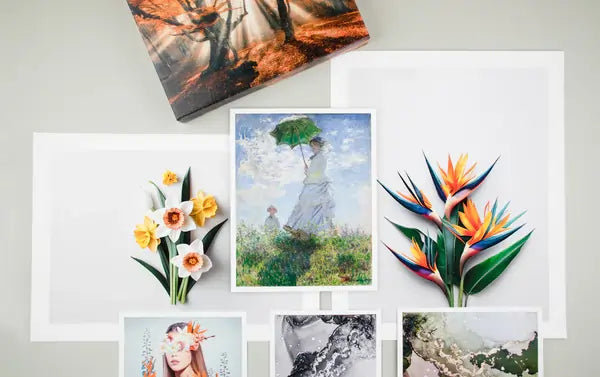TL;DR: The right frame enhances your art, protects it, and ties it beautifully to your space. Consider the material, proportion, color, and environment to create a professional, gallery-quality presentation.
Choosing the right frame for your artwork is both an art and a science. A frame not only complements the style and mood of your piece but also protects it for years to come. Whether you’re framing a fine art print, photograph, or canvas, understanding how color, proportion, and materials interact will help you achieve a cohesive and lasting display.
At The Stackhouse Printery, we help artists and photographers elevate their work with high-quality printing and professional display options. Here’s how to choose a frame that brings out the best in your artwork.
Understanding the Purpose of a Frame
A frame does more than hold your artwork—it defines and protects it. Frames create a boundary between the art and its environment, helping the viewer focus on the piece while shielding it from dust, moisture, and handling. A well-chosen frame makes your artwork feel complete and intentional.
Match the Frame to the Artwork’s Style
The artwork itself should guide your choice. Minimalist photographs and abstract prints pair well with sleek metal or thin wooden frames, while painterly giclée or traditional works often look best in warm wooden or ornate frames. The goal is to complement—not compete—with the art.
For modern presentations, floating frames are popular. They create a subtle gap between the canvas and the frame, offering a clean, gallery-ready appearance. For paper prints, matted frames add depth and visual breathing room. Explore our Matting Package Prints for ready-to-display fine art options.
Choosing the Right Frame Material
The material you choose should match the tone of your artwork and its setting:
- Wood Frames: Classic, warm, and versatile—perfect for textured or traditional pieces.
- Metal Frames: Modern, minimal, and ideal for photography or contemporary art.
- Floating Frames: Excellent for gallery-wrapped canvas prints to create a clean, modern look.
If you’re displaying loose canvas prints or unframed works, floating or shadowbox frames can add depth without covering the edges.
Size and Proportion Matter
The frame should complement your artwork’s scale. A small piece can feel lost in a wide, ornate frame, while a large artwork may look incomplete in a thin one. A good rule of thumb: the frame width should be roughly one-tenth of the artwork’s shortest side. This maintains visual balance without distraction.
Need help determining the best print and frame proportions? Check out our guide on Selecting Print Size and Border Options.
Matting and Mounting Options
Mats give your art room to breathe and add professional polish. They prevent paper prints from touching the glass, preserving their surface and color over time. Choose a neutral mat—white, off-white, or gray—for most prints, or a darker one to add contrast to light-toned artwork.
If your print already includes a border or is mounted, you may not need additional matting. Our Matting Package Prints come ready to frame with precision-cut mats included.
Consider the Space and Display Environment
Your frame should also suit the room it’s displayed in. A light wood frame might enhance a bright, natural space, while a darker or metallic frame might fit better in a formal or modern setting. For cohesive wall displays, use consistent frame colors and sizes to maintain visual flow.
If you’re hanging multiple works, keep consistent spacing and alignment. For large walls, use larger frames to anchor the room. For smaller spaces, smaller frames or unframed gallery wraps can provide balance without clutter.
Framing for Different Print Types
- Fine Art Prints: Use archival mats and UV-protective glass to ensure longevity. Learn more about our Giclée Fine Art Prints.
- Photo Prints: Sleek frames with minimal reflection pair best with glossy or metallic finishes. Shop photo prints for ideal framing options.
- Canvas Prints: Opt for floating frames or display them unframed for a clean, modern style. Our Gallery Wrapped Canvas Prints arrive ready to hang.
Common Framing Mistakes to Avoid
- Ignoring proportions: An oversized or undersized frame can throw off the composition.
- Using non-archival materials: Cheap mats or backings can discolor your art over time.
- Overly ornate designs: If the frame competes with your artwork, simplify.
- Neglecting placement: Avoid direct sunlight or humid areas unless using UV or moisture-resistant materials.
Preserve and Present Your Art Beautifully
The right frame brings harmony between your art and its surroundings. Whether you prefer traditional wood, contemporary metal, or a minimalist floating frame, thoughtful selection will ensure your artwork looks professional and lasts for decades.
At The Stackhouse Printery, we’re here to help you print, mount, and display your art beautifully. Request our Free Media Sample Set to explore our papers and finishes, or learn more about how to prepare your art for printing and framing.









